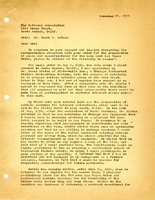Search the Special Collections and Archives Portal
Search Results

Letter from Homer Rissman to Frank S. Hofues, Santa Monica, December 21, 1955
Date
Archival Collection
Description
Five-page letter from Homer Rissman to Frank Hofues regarding the Lady Luck Casino, later named the Hacienda.
Text

Letter and envelope from Nellie Harrison, Pinto, Utah to Mary Etta Syphus, Panaca, Nevada
Date
Archival Collection
Description
From the Syphus-Bunker Papers (MS-00169). The folder contains an original handwritten letter, an envelope, a typed transcription of the same letter, and a copy of original letter attached.
Text

Dani McLaughlin oral history interview: transcript
Date
Archival Collection
Description
Oral history interview with Dani McLaughlin conducted by Barbara Tabach on February 14, 2018 for the Remembering 1 October Oral History Project. In this interview, Dani McLaughlin discusses the October 1, 2017 mass shooting in Las Vegas, Nevada and how she tried to find safety with her husband and a group of friends, one of whom was shot. She talks about finding refuge in her office at Atlantic Aviation. McLaughlin mentions the different ways her life and the lives of her family members have been affected, including how her children reacted to the shooting.
Text
The Production Company Audiovisual Collection
Identifier
Abstract
The Production Company Audiovisual Collection consists of commercials, advertising, and political campaigns from approximately 1965 to 1995 created by The Production Company, a television production company founded by Thomas “Bob” Patrick in Las Vegas, Nevada. The collection consists of primarily 16 mm film and video formats such as VHS, U-Matic, Betacam, open reel, Type C, and quadruplex. The videotapes and films in this collection represent advertising and marketing for hotels and casinos, entertainment companies, politicians, and local businesses located in Las Vegas, Nevada.
Archival Collection

University of Nevada, Las Vegas (UNLV) 23rd commencement program
Date
Archival Collection
Description
Commencement program from University of Nevada, Las Vegas Commencement Programs and Graduation Lists (UA-00115).
Text

Stewart family legal papers and certificates
Date
Archival Collection
Description
Stewart family legal papers and certificates
Text




